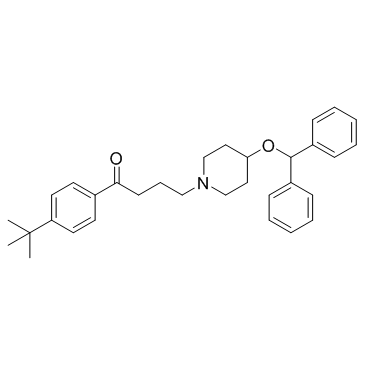Histamine H(1) antagonist treatment with pyrilamine reduces nicotine self-administration in rats.
Edward D Levin, Susan Slade, Corinne Wells, Margaret Pruitt, Vanessa Cousins, Marty Cauley, Ann Petro, Dawn Hampton, Jed Rose
文献索引:Eur. J. Pharmacol. 650(1) , 256-60, (2011)
全文:HTML全文
摘要
Nicotine has been definitively shown to be critically involved in the neural bases of tobacco addiction. However, nicotine releases a wide variety of neurotransmitters. Nicotine-induced dopamine release has been shown to play a key role in facilitating nicotine self-administration. Other transmitter systems may also play important roles in the pharmacological effects of nicotine and may provide important leads for combating nicotine self-administration. Clozapine, an antipsychotic drug, which blocks a variety of different transmitter receptors including serotonin 5HT(2) and histamine H(1) receptors, has been found to decrease smoking. Previously we found that the serotonin 5HT(2) antagonist, ketanserin, significantly reduced nicotine self-administration. In the current study, we assessed histamine H(1) receptor interaction with nicotine self-administration. Young adult female Sprague-Dawley rats were fitted with IV catheters and trained to self-administer nicotine (0.03mg/kg/infusion). Acute doses of 40mg/kg of pyrilamine, a histamine H(1) antagonist, significantly reduced nicotine self-administration. We also found that repeated injections (20mg/kg) or chronic infusion via osmotic minipumps (50mg/kg/day) of pyrilamine also significantly decreased nicotine self-administration. The peripherally restricted H(1) antagonist ebastine was ineffective in reducing nicotine self-administration, pointing to central H(1) receptor blockade as key for the effectiveness of pyrilamine. H(1) antagonists may be a promising avenue to explore for new treatments to aid smoking cessation.Copyright © 2010 Elsevier B.V. All rights reserved.
相关化合物
| 结构式 | 名称/CAS号 | 分子式 | 全部文献 |
|---|---|---|---|
 |
依巴斯汀
CAS:90729-43-4 |
C32H39NO2 |
|
Anaphylaxis to oral iron salts. desensitization protocol for...
2008-01-01 [J. Investig. Allergol. Clin. Immunol. 18(4) , 305-8, (2008)] |
|
A novel approach for predicting P-glycoprotein (ABCB1) inhib...
2011-03-24 [J. Med. Chem. 54 , 1740-51, (2011)] |
|
New therapies for allergic rhinitis.
2014-04-01 [Curr. Allergy Asthma Rep. 14(4) , 422, (2014)] |
|
Analysis of disease-dependent sedative profiles of H(1)-anti...
2008-07-01 [Methods Find. Exp. Clin. Pharmacol. 30(3) , 225-30, (2008)] |
|
Acquired cold urticaria symptoms can be safely prevented by ...
2007-12-01 [Allergy 62(12) , 1465-8, (2007)] |